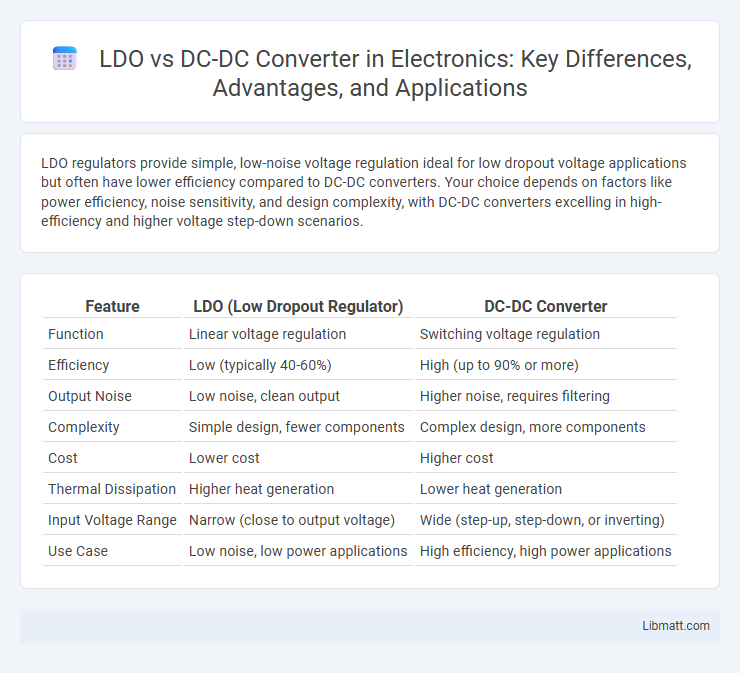LDO regulators provide simple, low-noise voltage regulation ideal for low dropout voltage applications but often have lower efficiency compared to DC-DC converters. Your choice depends on factors like power efficiency, noise sensitivity, and design complexity, with DC-DC converters excelling in high-efficiency and higher voltage step-down scenarios.
Table of Comparison
| Feature | LDO (Low Dropout Regulator) | DC-DC Converter |
|---|---|---|
| Function | Linear voltage regulation | Switching voltage regulation |
| Efficiency | Low (typically 40-60%) | High (up to 90% or more) |
| Output Noise | Low noise, clean output | Higher noise, requires filtering |
| Complexity | Simple design, fewer components | Complex design, more components |
| Cost | Lower cost | Higher cost |
| Thermal Dissipation | Higher heat generation | Lower heat generation |
| Input Voltage Range | Narrow (close to output voltage) | Wide (step-up, step-down, or inverting) |
| Use Case | Low noise, low power applications | High efficiency, high power applications |
Introduction to Power Regulation
LDO (Low Dropout Regulator) and DC-DC converters are essential components in power regulation, each offering distinct methods of voltage conversion. LDO regulators provide a simple, linear voltage regulation with low noise and fast transient response, ideal for low voltage differences and sensitive analog circuits. DC-DC converters, based on switching technology, efficiently step up or step down voltage with higher power efficiency, making them suitable for applications requiring significant voltage variation and energy savings.
What is an LDO Regulator?
An LDO regulator, or Low Dropout Regulator, is a type of linear voltage regulator designed to maintain a steady output voltage even when the input voltage is very close to the output voltage. Unlike DC-DC converters, LDOs provide clean, low-noise power ideal for sensitive analog circuits and RF applications. Your choice depends on factors like efficiency, noise tolerance, and the voltage difference between input and output.
How DC-DC Converters Work
DC-DC converters regulate voltage by switching elements like transistors on and off rapidly, storing energy in inductors or capacitors and releasing it to maintain a stable output voltage. Unlike LDOs, which dissipate excess voltage as heat, DC-DC converters achieve higher efficiency through this energy transfer process. Your electronic device benefits from longer battery life and reduced heat generation when using an appropriately designed DC-DC converter.
Efficiency Comparison: LDO vs DC-DC
LDO regulators typically offer lower efficiency, especially when the input voltage is significantly higher than the output voltage, resulting in higher power dissipation as heat. DC-DC converters, such as buck or boost converters, achieve higher efficiency by switching elements on and off rapidly, often reaching 80-95% efficiency or more depending on the design. Your choice between LDO and DC-DC should consider efficiency requirements, as DC-DC converters save more energy in high voltage-drop scenarios, reducing thermal management needs.
Noise Performance: LDO vs Switching Regulators
Low Dropout Regulators (LDOs) offer superior noise performance compared to DC-DC switching converters, producing minimal output ripple and electromagnetic interference (EMI) due to their linear operation. Switching regulators, such as buck or boost converters, inherently generate higher noise and switching ripple because of their high-frequency switching action. Designers often choose LDOs for sensitive analog circuits and RF applications where low noise and clean power supply lines are critical.
Size and Component Count Differences
LDO regulators typically have a smaller component count and simpler circuit design compared to DC-DC converters, making them more compact and easier to implement in space-constrained applications. DC-DC converters generally require larger inductors, capacitors, and switching elements, leading to increased size and complexity on the PCB. The size difference becomes more pronounced at higher power levels, where DC-DC converters offer better efficiency despite their larger footprint.
Application Scenarios for LDOs
LDO regulators excel in applications requiring low noise and minimal power supply ripple, such as audio devices, RF circuits, and precision analog components. Your design benefits from LDOs when voltage differences between input and output are small, maximizing efficiency in battery-powered or low-dropout scenarios. These regulators are ideal for sensitive electronics needing stable voltage with simple, compact circuitry.
Use Cases for DC-DC Converters
DC-DC converters are ideal for applications requiring efficient voltage conversion, such as battery-powered devices, automotive systems, and renewable energy solutions, where maintaining longer battery life and stable power is critical. These converters support wide input voltage ranges and deliver high power density, making them suitable for portable electronics, industrial equipment, and communication devices. Choosing a DC-DC converter can optimize Your power management by reducing heat dissipation and improving overall system efficiency in demanding environments.
Cost Considerations in Power Design
LDO regulators generally offer lower upfront costs and simpler circuit design compared to DC-DC converters, making them cost-effective for low-power or noise-sensitive applications. DC-DC converters, though more complex and expensive initially due to components like inductors and feedback control, provide higher efficiency and can reduce long-term power costs in high-current or battery-powered designs. Evaluating total cost of ownership requires balancing component expenses with efficiency gains and thermal management savings over the device's operational lifetime.
Choosing Between LDOs and DC-DC Converters
Choosing between LDOs and DC-DC converters depends on efficiency, noise sensitivity, and complexity requirements. LDOs offer simple design and low noise output, ideal for noise-sensitive analog circuits, while DC-DC converters provide higher efficiency for applications with significant voltage drops or higher current demands. Evaluating power budget, thermal constraints, and load stability guides the optimal regulator selection for specific electronic designs.
LDO vs DC-DC Converter Infographic

 libmatt.com
libmatt.com